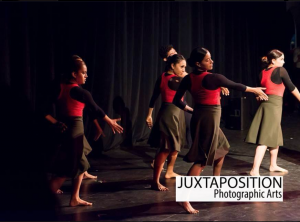Passionate “Journey to the Soul” of Jose Limon at SD Fringe
 Celeste Lanuza dances–she’s director of San Diego-based Celeste Lanuza Dance Theatre and has an MFA in choreography from the University of California-Irvine. Lanuza sings, as well–she’s just released a CD, and she does several sweet-voiced live numbers in “Solo y Juntos: Al Camino de Alma,” her show at the Lyceum Theatre, part of the San Diego International Fringe Festival.
Celeste Lanuza dances–she’s director of San Diego-based Celeste Lanuza Dance Theatre and has an MFA in choreography from the University of California-Irvine. Lanuza sings, as well–she’s just released a CD, and she does several sweet-voiced live numbers in “Solo y Juntos: Al Camino de Alma,” her show at the Lyceum Theatre, part of the San Diego International Fringe Festival.
Best of all, Lanuza thinks. “Solo y Juntos” is a deeply researched piece that celebrates the brilliant modern dance pioneer Jose Limon (1908-1972). The half-hour dance theater piece features breathtaking, complex choreography performed by a strong eight-dancer ensemble, live original music by a five-piece band (with rocking violin from David Morales-Boroff), and spoken word from Limon’s unpublished memoir.
The piece’s title translates as “Alone and Together: Journey to the Soul,” and it begins with Limon’s journey as a child from Mexico to Los Angeles in 1915. His family was fleeing the turmoil of the Mexican Revolution, and a chorus of six women and one man, chests crossed by bandoleers, slap out percussion with their feet and hands as the Limon character (the dashing Lorenzo Francisco Penney) tells of “coming into an unfriendly country.” Unfriendly, indeed, as the chorus forms a combative circle around him. There’s a clash with another man that made me think of “West Side Story,” and he collapses to the ground. The chorus sections are stunning, with interesting new moves coming lickety-split, and the fine dancers tight as can be.
Three women try to revive him. I took the one in an orange folklorico-style dress (Gloria Lanuza, Celeste’s sister, who moves with gorgeous authority) to represent Mexican culture, a bandoleered woman (Celeste Lanuza) as the spirit of revolution, and a figure in a white dress (Ana Erim Mendoza) as a mother, a lover, or Art. It’s Art who brings him back to life, as Penney swoops Mendoza into joyous lifts and brandishes his white shirt like a bullfighter’s cape. And then the chorus is back doing a crouching line dance that morphs into an exuberant salsa they take into the audience.
[php snippet=1] “Solo y Juntos” is a hugely ambitious project, and there are some rough spots. There’s a fairly static section when the three women first come out. And the spoken word sections felt weaker than the other elements. It’s always a challenge to have a dancer deliver lines, but I suspect it was partly a problem with the material itself, whether it’s just not that compelling–Limon was a dance genius, he didn’t need to be a brilliant writer, as well–or the memoir excerpts need to be fuller or woven in more expertly. And, speaking as someone whose eardrums were not blown out by rock concerts in my youth, the sound level was painful–an easy fix.
And the overall flow seemed a bit balky, with the static moments partway through and an ending that felt rushed. I wanted more!
A post-performance talk provided more background on the piece and on Limon, and this might be a piece where the talk should come first. Certainly, it’s a piece that should be shown again–and that you should catch in its last two shows during the Fringe, tonight at 9:30 and Saturday at 5:00 p.m.

Award-winning dance journalist Janice Steinberg has published more than 400 articles in the San Diego Union-Tribune, Dance Magazine, the Los Angeles Times, and elsewhere. She was a 2004 New York Times-National Endowment for the Arts fellow at the Institute for Dance Criticism and has taught dance criticism at San Diego State University. She is also a novelist, author of The Tin Horse (Random House, 2013). For why she’s passionate about dance, see this article on her web site, The Tin Horse
